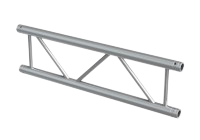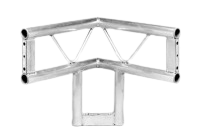Ladder Truss: An Established Choice for Stage and Display Rigging
In stagecraft and live event work, weight, space, and turnaround times determine much of the rigging plan. Ladder truss has earned constant placement in that plan thanks to a profile that remains slim without surrendering stability. Formed from two parallel chords linked by regular braces, it resembles a ladder turned on its side, which explains the name that has followed the format since its introduction decades ago.
The Structure in Brief
Two chords carry the load; cross-members keep those chords fixed at set distances. That arrangement delivers a modest self-weight yet controls flex across short to medium spans. Because the truss is no wider than its two main tubes, it travels well and stores tidily against warehouse walls or in flight cases. The compact outline also lets riggers squeeze extra fixtures into tight wings or ceiling voids that cannot accept bulkier frames.
Twin Truss and Duo Truss at a Glance
Within the wider ladder family sit twin truss and duo truss models. Both rely on the twin-chord principle, though brace patterns and tube sizes alter performance slightly. Twin truss often uses deeper chords for marginally higher capacity, whereas duo truss may adopt lighter tubes if the brief prioritises handling over load. Selecting between the two tends to come down to span length, point loads, and the clearance available around the finished run.
- Twin truss – favoured where the truss must bridge longer gaps with minimal mid-support.
- Duo truss – common in exhibition builds and retail displays where personnel might install and remove sections daily.
Ladder Truss Lighting Practices
Lighting ladder truss continues to fill sidelight positions in theatres, boom towers in concert touring, and border positions in television studios. Technicians appreciate unrestricted access along the chords, which allows clamps to be placed exactly where beam angles demand. Cables dress neatly along a brace line, leaving a clear path for shutters, barn doors, and lens tubes to move without snagging.
Common Mounting Approaches
- Vertical ladders placed at stage left and right for cross-light.
- Horizontal runs flown downstage for front washes.
- Short drops configured as banner supports over trade-show aisles.
- Compact truss pieces fixed to truss towers for crowd banner placements at sporting venues.
Why Aluminium Remains the Material of Choice
The bulk of modern ladder truss is produced from aluminium. That alloy supplies a solid strength-to-weight ratio while resisting oxidation, which is helpful for kit that shifts between humid clubs, air-conditioned halls, and outdoor sites. Lower mass lets smaller crews build or strike rigs rapidly and keeps transport bills in check.
Additional Advantages
- Compatible with the majority of fork or spigot connectors already used on stage.
- Clean, brushed finish that blends into both corporate installations and festival roofs.
- Minimal maintenance beyond routine inspection and an occasional wipe-down.
Lighting Ladder Truss System Integration
Because ladder sections share connector standards with larger formats, they slot into mixed rigs with little fuss. A lighting truss system may therefore employ ladder spans for lighter fixtures at the wings, square truss for centre clusters, and pre-rig for automated luminaires—all fixed through common plates or half couplers. Mixing profiles in this way brings down overall dead load without introducing unfamiliar fittings.
Portable Lighting Truss Considerations
Touring theatre, dry-hire suppliers, and corporate roadshows demand equipment that survives repeated trucking yet assembles rapidly. Portable lighting truss built around aluminium ladder sections checks each box: shorter pieces slot into standard vans, corner adapters stay with the sections, and two technicians can raise a simple goalpost with a pair of wind-up stands in minutes. When the call sheet moves on, the same ladder sections stack quickly, keeping load-out tight.
Typical Usage Scenarios
Though familiar across many disciplines, certain applications appear again and again:
- Theatres – vertical ladders at proscenium edges for wing light positions.
- Music venues – front rows of PAR cans hung from short ladder spans flown just inside the downstage line.
- Exhibitions – narrow overhead banner supports where floor space attracts a premium.
- Retail – window displays that change weekly, requiring manageable truss to suspend point-of-sale lighting.
- Film sets – quick-upright frames to hold backlight units, diffusers, or grid cloths.
Custom Lengths and Connectors
Manufacturers deliver standard lengths—0.5m, 1m, 2m, 3m are common—yet bespoke cuts arrive regularly when site drawings dictate. Spigot connections stay prevalent, although bolt-through and tapered pin couplings appear where silent assembly or strict weight limits apply. Most suppliers stock adaptors that bridge between brands, ensuring legacy stock still earns its keep.
Accessories That Make Life Easier
Couplers now exist for almost every tube diameter on the market. Beyond those basics, the following parts appear in most cases:
- Swivel clamps for angled fixture aiming.
- Saddle plates that bridge between ladder truss and drape tracks.
- Base plates with levelling feet for ground-stacked vertical ladders.
- Safety bond eyes and cable retainers to tidy power and DMX lines.
Routine Care and Inspection
Aluminium ladder truss repays simple, regular checks. Inspect weld beads for cracking, confirm connectors remain true, and replace any deformed pins immediately. Cleaning involves little more than a soft cloth and mild detergent; solvents risk dulling the mill finish. Storage on padded racking prevents dented chords and keeps alignment accurate for subsequent builds.
Summary
Ladder truss, accompanied by its twin truss and duo truss variants, supplies a lean solution for lighting, signage, and general event rigging. The format’s low mass, compatibility with current hardware, and ease of transport maintain its popularity in both fixed installations and portable lighting truss packages. Whether the brief covers a regional theatre, a travelling corporate show, or a one-off exhibition stand, aluminium ladder truss often satisfies capacity, budget, and build-time requirements in a single choice.











